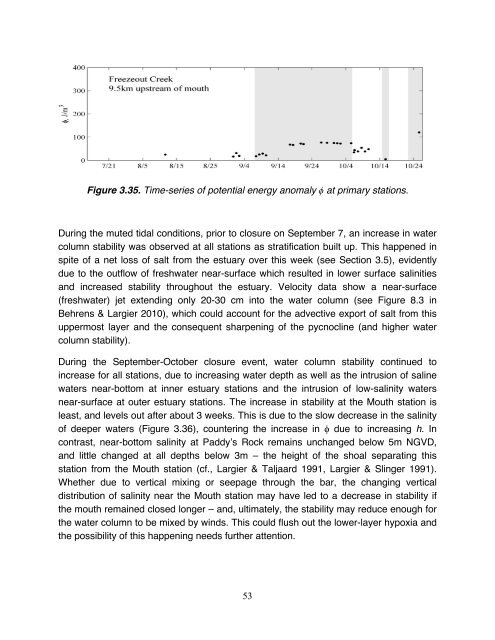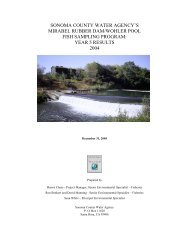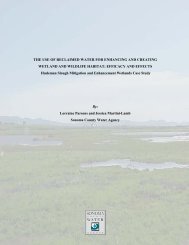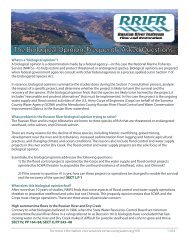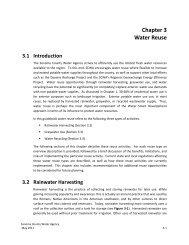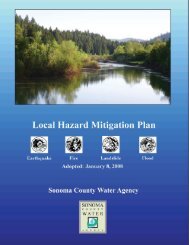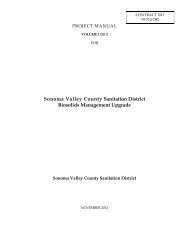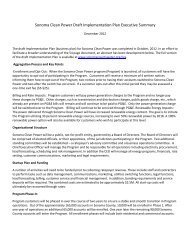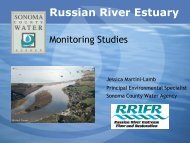Hydrography of the Russian River Estuary - Sonoma County Water ...
Hydrography of the Russian River Estuary - Sonoma County Water ...
Hydrography of the Russian River Estuary - Sonoma County Water ...
You also want an ePaper? Increase the reach of your titles
YUMPU automatically turns print PDFs into web optimized ePapers that Google loves.
Figure 3.35. Time-series <strong>of</strong> potential energy anomaly ϕ at primary stations.<br />
During <strong>the</strong> muted tidal conditions, prior to closure on September 7, an increase in water<br />
column stability was observed at all stations as stratification built up. This happened in<br />
spite <strong>of</strong> a net loss <strong>of</strong> salt from <strong>the</strong> estuary over this week (see Section 3.5), evidently<br />
due to <strong>the</strong> outflow <strong>of</strong> freshwater near-surface which resulted in lower surface salinities<br />
and increased stability throughout <strong>the</strong> estuary. Velocity data show a near-surface<br />
(freshwater) jet extending only 20-30 cm into <strong>the</strong> water column (see Figure 8.3 in<br />
Behrens & Largier 2010), which could account for <strong>the</strong> advective export <strong>of</strong> salt from this<br />
uppermost layer and <strong>the</strong> consequent sharpening <strong>of</strong> <strong>the</strong> pycnocline (and higher water<br />
column stability).<br />
During <strong>the</strong> September-October closure event, water column stability continued to<br />
increase for all stations, due to increasing water depth as well as <strong>the</strong> intrusion <strong>of</strong> saline<br />
waters near-bottom at inner estuary stations and <strong>the</strong> intrusion <strong>of</strong> low-salinity waters<br />
near-surface at outer estuary stations. The increase in stability at <strong>the</strong> Mouth station is<br />
least, and levels out after about 3 weeks. This is due to <strong>the</strong> slow decrease in <strong>the</strong> salinity<br />
<strong>of</strong> deeper waters (Figure 3.36), countering <strong>the</strong> increase in ϕ due to increasing h. In<br />
contrast, near-bottom salinity at Paddyʼs Rock remains unchanged below 5m NGVD,<br />
and little changed at all depths below 3m – <strong>the</strong> height <strong>of</strong> <strong>the</strong> shoal separating this<br />
station from <strong>the</strong> Mouth station (cf., Largier & Taljaard 1991, Largier & Slinger 1991).<br />
Whe<strong>the</strong>r due to vertical mixing or seepage through <strong>the</strong> bar, <strong>the</strong> changing vertical<br />
distribution <strong>of</strong> salinity near <strong>the</strong> Mouth station may have led to a decrease in stability if<br />
<strong>the</strong> mouth remained closed longer – and, ultimately, <strong>the</strong> stability may reduce enough for<br />
<strong>the</strong> water column to be mixed by winds. This could flush out <strong>the</strong> lower-layer hypoxia and<br />
<strong>the</strong> possibility <strong>of</strong> this happening needs fur<strong>the</strong>r attention.<br />
53


